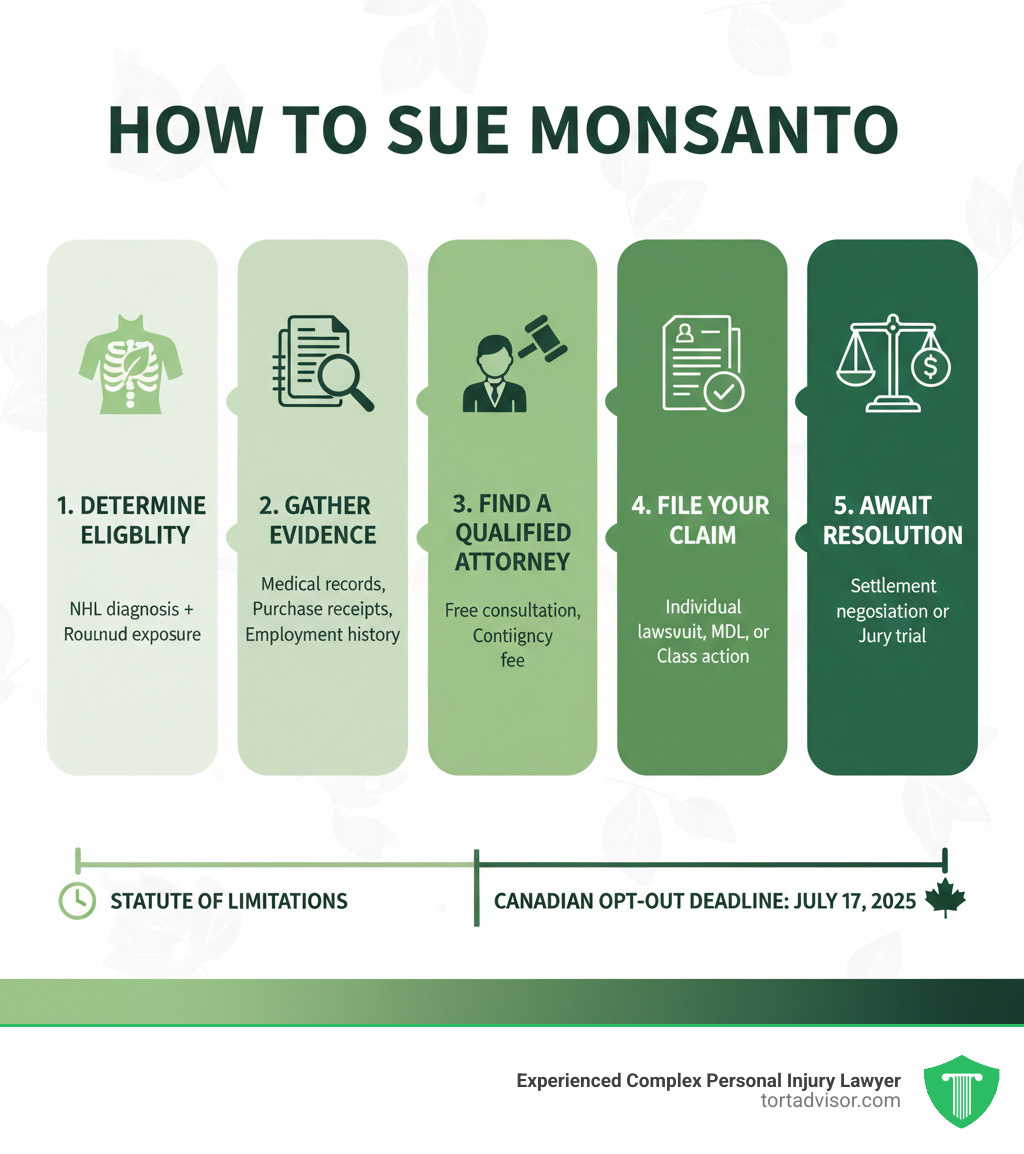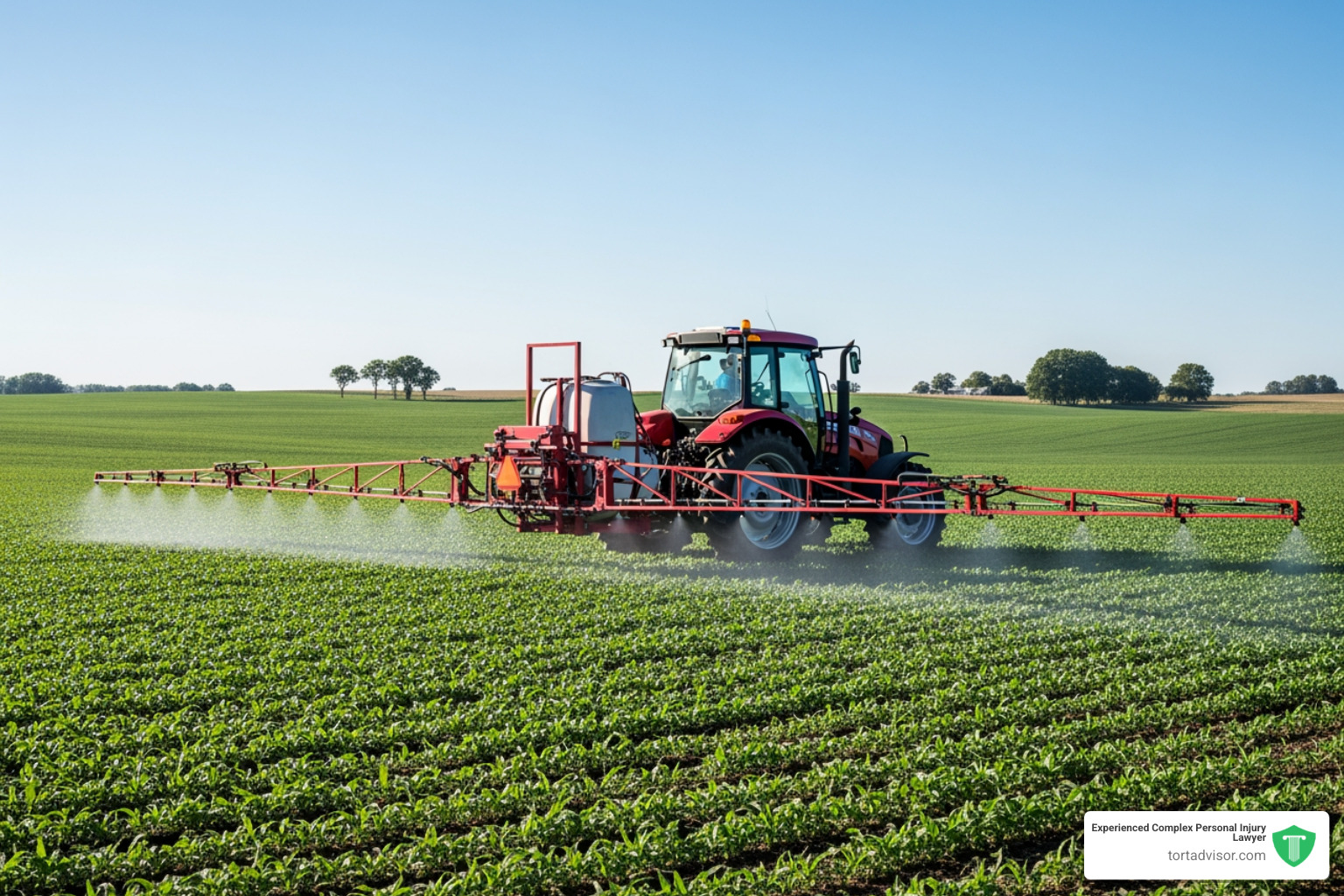


Why Thousands Are Taking Legal Action Against a Corporate Giant
How to sue Monsanto involves key steps for individuals diagnosed with Non-Hodgkin’s Lymphoma after Roundup exposure:
- Determine Eligibility: You need a Non-Hodgkin’s Lymphoma diagnosis (or related cancer) after significant exposure to Roundup.
- Document Your Exposure: Gather proof of Roundup use, such as receipts, employment records, and photos.
- Obtain Medical Records: Compile all medical documents related to your cancer diagnosis and treatment.
- Contact a Qualified Attorney: Seek a free consultation with a mass tort lawyer. Most work on contingency, meaning no upfront fees.
- File Within the Statute of Limitations: Act quickly, as legal deadlines to file a lawsuit vary by state.
- Join Existing Litigation: Your lawyer will likely file your case within the federal Multidistrict Litigation (MDL) or state court proceedings.
Once a household staple, Monsanto’s Roundup is now at the center of one of history’s largest product liability cases. Since Bayer acquired Monsanto, tens of thousands have filed lawsuits alleging the herbicide caused their Non-Hodgkin’s Lymphoma. While Bayer has paid roughly $11 billion to settle nearly 100,000 claims, about 61,000 active lawsuits are still pending.
The legal battle grew after the International Agency for Research on Cancer classified glyphosate—Roundup’s active ingredient—as “probably carcinogenic to humans” in 2015. Since then, juries have delivered massive verdicts, including a $2.25 billion award in the McKivision case, reflecting evidence that Monsanto knew of the cancer risks but failed to warn consumers.
If you are a farmer, landscaper, or home gardener diagnosed with cancer after Roundup use, you may be entitled to significant compensation. This guide will walk you through the process, from determining eligibility to understanding potential compensation.
Do You Have a Case? Eligibility for a Roundup Lawsuit
If you were diagnosed with Non-Hodgkin’s Lymphoma after using Roundup, you may have a valid legal claim. Eligibility depends on three factors: your medical diagnosis, your history of exposure to the product, and filing within the legal deadline. Understanding how to sue Monsanto begins with connecting your health to your contact with this herbicide.
Who is Eligible to Sue Monsanto for Roundup Exposure?
Many people beyond farmers qualify for these lawsuits. Eligible plaintiffs include:
- Agricultural workers who regularly applied Roundup to crops.
- Landscapers and groundskeepers who used the product frequently to maintain properties.
- Nursery and greenhouse employees who worked around plants treated with glyphosate.
- Home gardeners with a history of consistent Roundup use around their yards.
- Family members who may file a wrongful death claim if a loved one passed away from Non-Hodgkin’s Lymphoma linked to Roundup.
The key requirement is establishing a direct link between Roundup exposure and the cancer diagnosis. For more details, explore our guide on Monsanto Roundup Lawsuits.
The Link Between Roundup and Non-Hodgkin’s Lymphoma
Non-Hodgkin’s Lymphoma is a cancer of the lymphocytes, the white blood cells that protect you from disease. The legal cases against Monsanto hinge on a 2015 finding by the International Agency for Research on Cancer (IARC), which classified glyphosate as “probably carcinogenic to humans.” This classification, based on extensive scientific research on glyphosate’s carcinogenicity, gave scientific weight to what many had long suspected.
Your medical records are critical evidence. They document your diagnosis, treatment, and prognosis, helping to establish that Roundup likely caused your cancer. Several subtypes of Non-Hodgkin’s Lymphoma have been linked to Roundup in lawsuits, including Diffuse Large B-Cell Lymphoma, Follicular Lymphoma, Mantle Cell Lymphoma, and Chronic Lymphocytic Leukemia.
What Constitutes ‘Significant Exposure’?
Not everyone who has used Roundup qualifies for a lawsuit. The legal standard is “significant exposure,” which means consistent, prolonged contact over months or years. A one-time use is typically not enough.
- Occupational exposure is the clearest case. If your job required regular spraying of Roundup, you likely meet this standard. Employment records and coworker testimony can help prove this.
- Residential use can also qualify if it was frequent and long-term. A pattern of spraying your lawn, garden, or fence line every season for years can add up to significant exposure.
The frequency and duration of use are critical. The Canadian class action offers a helpful benchmark, defining it as applying glyphosate more than twice in a year and over 10 occasions in a lifetime. Gathering evidence like receipts, photos, or witness statements to document your exposure history will strengthen your case considerably.
The Allegations: What is Monsanto Accused Of?
Lawsuits against Monsanto and its parent company, Bayer, are about more than just a dangerous product; they allege corporate deception and a prioritization of profits over public health. Understanding these accusations is key to grasping how to sue Monsanto and why juries have awarded such massive verdicts.
Key Allegations Against Monsanto and Bayer
Lawsuits allege that Monsanto knew about the cancer risks associated with glyphosate for decades but deliberately hid this information. The central claims include:
- Deceptive Marketing: Promoting Roundup as safe while internal documents suggested the company had concerns about its health effects.
- Ghostwriting Scientific Studies: Internal “Monsanto Papers” suggest the company ghostwrote favorable research and published it under the names of independent academics to create a false sense of safety.
- Discrediting Scientists: Running campaigns to undermine the credibility of independent researchers and organizations, like the IARC, whose findings challenged glyphosate’s safety.
- Prioritizing Profits Over Safety: Choosing to protect market share instead of warning consumers or reformulating the product.
When Bayer acquired Monsanto for $63 billion in 2018, it inherited these liabilities. For more on the company’s history, see our page on the Roundup Weed Killer Manufacturer.
The Scientific and Regulatory Conflict
A confusing aspect of this litigation is the conflict between scientific bodies. In 2015, the International Agency for Research on Cancer (IARC) classified glyphosate as “probably carcinogenic to humans” based on evidence of cancer in humans and lab animals. You can read the scientific research on glyphosate’s carcinogenicity that informed this decision.
However, the U.S. Environmental Protection Agency (EPA) maintains that glyphosate is “not likely to be carcinogenic.” Bayer uses the EPA’s position to argue for federal preemption—the idea that federal approval of its label prevents states from requiring a separate cancer warning. Courts have been divided on this issue, but many have rejected the argument, allowing negligence and failure-to-warn claims to proceed to a jury.
How to Sue Monsanto: A Step-by-Step Guide
Taking legal action against a corporate giant like Monsanto can feel daunting, but the process is straightforward with the right support. We’ve helped thousands of people take their first steps toward justice, and we’re here to guide you through each stage.
Step 1: Seek a Free Case Evaluation from a Mass Tort Attorney
Your first step is a free consultation with an experienced mass tort attorney. These lawyers specialize in cases where a single product harms many people and have the resources to challenge large corporations. They will assess your claim and explain your legal options.
Most mass tort attorneys work on a contingency fee basis. This means you pay no upfront fees. The attorney only gets paid if they successfully recover compensation for you, ensuring everyone has access to justice regardless of their financial situation.
Step 2: Gather Evidence to Prove Your Claim
Building a strong case requires solid evidence. Your legal team will guide you, but you can start gathering key documents early.
- Proof of Roundup use is essential. This includes purchase receipts, credit card statements, photos of you using the product, or employment records detailing your job duties.
- Medical records are the other critical pillar. You’ll need complete documentation of your Non-Hodgkin’s Lymphoma diagnosis, including pathology reports, treatment plans, and medical bills.
- Witness statements from family, friends, or coworkers can add credibility by confirming your regular use of Roundup.
The more detailed your records, the better your legal team can negotiate a fair settlement or present a compelling case at trial.
Step 3: Understanding the Legal Process for How to Sue Monsanto
Most Roundup claims in the U.S. are consolidated into a Multidistrict Litigation (MDL). The federal Roundup MDL, based in the Northern District of California, streamlines pretrial proceedings like discovery. An MDL is different from a Class Action Lawsuit Against Roundup; in an MDL, you retain your individual lawsuit and the potential for a settlement based on your unique damages.
Some lawsuits are filed in state courts, particularly in Missouri, California, and Pennsylvania, which can offer strategic advantages. A few proceed as individual lawsuits outside of these larger consolidations. Your attorney will evaluate your situation and recommend the most strategic path to secure fair compensation. For more on the litigation landscape, visit our page on Monsanto Roundup Lawsuits.
What to Expect: Verdicts, Settlements, and Payouts
When you consider how to sue Monsanto, a primary question is about compensation. The results in Roundup litigation have been extraordinary, with massive jury verdicts and substantial settlement agreements. Understanding these outcomes can help you gauge the potential value of your claim.
Landmark Roundup Verdicts and Their Impact
Juries have consistently sent a powerful message to Bayer. In recent years, they have awarded billions to plaintiffs, demonstrating how seriously they view the company’s alleged misconduct.
Landmark verdicts include $2.25 billion for John McKivison (later reduced to $400 million), $1.5 billion for three Missouri plaintiffs, and $175 million for Ernest Caranci. These awards typically include compensatory damages to cover actual losses like medical bills and lost wages, and punitive damages to punish Monsanto for hiding the product’s risks. This pattern of multi-million and billion-dollar verdicts shows that juries are holding Bayer accountable. For more details, visit our Roundup Lawsuit Verdict page.
How Roundup Settlement Payouts Are Determined
Most cases settle before trial. Bayer has already paid approximately $11 billion to resolve nearly 100,000 lawsuits. Settlement amounts are not arbitrary; they are calculated using a structured system based on the specifics of your case.
Key factors that determine your compensation include:
- Your age at diagnosis.
- The level and duration of your Roundup exposure.
- The severity of your cancer and its prognosis.
- Documented financial losses, including medical expenses and lost income.
While trial verdicts can be enormous, settlements are typically more modest. In the initial settlement program, most payouts ranged from $100,000 to $160,000, though cases with more severe damages received significantly more. To get a rough estimate, you can Use our Roundup Settlement Calculator.
When Will I Get My Roundup Settlement Check?
This is a common and understandable question. The timeline depends on how your case is resolved. If you reach an individual settlement, you can often expect a check within a few months after your attorney resolves any medical liens and deducts legal fees.
For large settlement programs involving thousands of claimants, the process is longer. A claims administrator must review each claim package, assign it to a compensation tier, and calculate the payout. This administrative phase can be frustratingly slow, but it is designed to ensure fair distribution. Our team will keep you informed of any developments. For more on payment timelines, see our page on When Roundup Settlements Will Be Paid.
Frequently Asked Questions about How to Sue Monsanto
Deciding to pursue a claim against a major corporation raises many questions. Here, we address the most common concerns people have when learning how to sue Monsanto.
What is the statute of limitations for a Roundup lawsuit?
The statute of limitations is a critical deadline for filing a lawsuit. This deadline varies by state, but it is often two or three years. The clock typically starts ticking on the date you were diagnosed with Non-Hodgkin’s Lymphoma or the date you reasonably discovered the connection between your illness and Roundup exposure (this is known as the “discovery rule”). Acting quickly is essential, because if you miss the deadline, you lose your right to sue permanently, no matter how strong your case is.
What is the current status of the Canadian Roundup class action?
A Canadian Roundup class action was certified in late 2023. It includes Canadians who had “Significant Exposure” to Roundup and were subsequently diagnosed with Non-Hodgkin’s Lymphoma. The most critical date for class members is July 17, 2025—the opt-out deadline. If you are part of this group, you must decide by this date whether to remain in the class action or opt out to pursue an individual lawsuit. If you do nothing, you will be automatically included and bound by the class action’s outcome. You can find official information at www.glyphosateclassaction.ca.
What is the potential future of Roundup litigation?
The legal battle over Roundup is far from over, with approximately 61,000 active lawsuits still pending in the U.S. Bayer continues to face immense pressure, setting aside billions for litigation reserves as it contends with ongoing costs.
Bayer has outlined a five-point plan to manage the litigation, which includes defending some cases at trial, exploring new settlement structures, and removing glyphosate from its U.S. residential Roundup products. There has also been speculation about a potential Chapter 11 bankruptcy filing for the Monsanto subsidiary to manage its massive liabilities. With more trials scheduled and juries continuing to award substantial verdicts, the legal landscape remains dynamic, making it an important time for potential claimants to act.
Conclusion: Your Path to Justice
You now understand the key steps for how to sue Monsanto. While taking on a corporate giant like Bayer is daunting, you don’t have to do it alone. Juries have awarded billions and nearly 100,000 people have already secured settlements, proving that individuals can win when companies put profits ahead of safety.
Your Non-Hodgkin’s Lymphoma diagnosis after Roundup exposure may entitle you to significant compensation for your medical bills, lost income, and suffering. However, strict state deadlines called statutes of limitations mean you must act quickly before you lose your right to file a claim.
At Tort Advisor, we connect individuals like you with experienced mass tort attorneys who specialize in toxic exposure cases. They understand the science, the legal process, and how to build a strong claim on your behalf. They work on contingency, so you pay no upfront fees and only pay if you win.
A free case evaluation costs nothing and can provide the clarity you need. Learn if you have a valid claim, what it might be worth, and how to proceed. We believe that corporations should be held responsible when their products cause harm.
Your journey toward justice starts with a single step. Let us help you take it. Find legal help for Monsanto Roundup Lawsuits and connect with an experienced attorney who will fight for the compensation you deserve.
Free Confidential Case Evaluation
Complete the short form below to get an immediate FREE case review with an expert in your specific claim. Don't wait, your case could be time sensitive to file a claim.
Related Posts
Did a North Dakota product cause harm? Understand product liability, your rights, and how to take action for defects.
Get justice for clergy abuse. Find an expert Priest abuse lawyer to navigate complex laws and hold institutions accountable.
Diagnosed with meningioma after Depo-Provera? Understand potential Depo-Provera lawsuit settlements, risks, & how to claim compensation.
Uncover the truth about uber sexual assault cases. Learn about the alarming scale, Uber's accountability, and legal options for justice.
Facing wildfire losses? Discover the best wildfire lawsuit attorneys in California to fight for your full recovery and justice.
Exposed to Roundup & diagnosed with NHL? Discover how to sue Monsanto, understand eligibility, & seek compensation. Your guide to justice.









